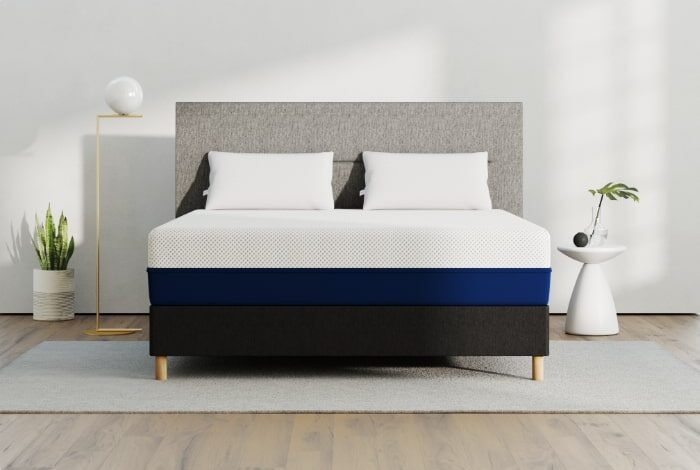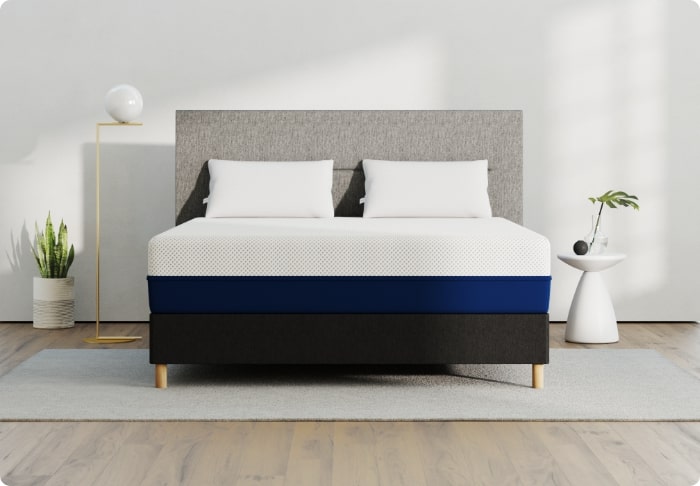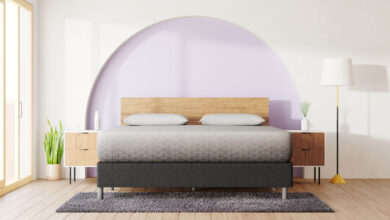Things in the Bedroom that Can Make You Sick

Key Takeaways
- Replace bedding regularly and wash weekly in hot water: Pillows every 2 years, mattresses every 8 years, and wash sheets weekly at 130°F+ to eliminate dust mites, bacteria, and accumulated allergens.
- Control moisture and maintain airflow: Keep humidity below 50% with proper ventilation (15 minutes daily window opening), use dehumidifiers if needed, and ensure good air circulation to prevent mold growth.
- Keep electronics 3+ feet from your bed: Distance yourself from EMF exposure and blue light disruption by creating a charging station away from your sleep area and maintaining the bedroom as a tech-free zone.
Your bedroom should be your safe haven, but it might be making you sick without you knowing it. Every night, you spend about eight hours breathing, sweating, and shedding skin cells in this space—that’s one-third of your life!
Various health hazards could be building up around you, from invisible dust mites to sneaky mold spores. These unwanted guests don’t just affect your sleep, they can impact your overall health and well-being in surprising ways.
The good news is that you can take control of your bedroom environment with some simple changes and regular maintenance. Taking action now can help you create a healthier sleep space and improve your quality of life.
Dust and Allergens
Your bedroom might look clean at first glance, but microscopic threats could be lurking in every corner. These invisible invaders can turn your sleep sanctuary into a source of persistent health problems if left unchecked.
Dust Mite Accumulation
Tiny dust mites make themselves at home in your mattress and pillows, feeding on the thousands of dead skin cells you shed every night. These microscopic creatures multiply rapidly, with a single female laying up to 100 eggs in her lifetime.
The average mattress can harbor between 100,000 to 10 million dust mites, creating a hidden ecosystem right under your sleeping body. Even if you can’t see them, they’re constantly producing waste that becomes part of the dust in your bedroom and can irritate the senses.
The longer you keep your mattress and pillows, the more these unwanted guests multiply and make themselves comfortable in your bedding. During your nightly toss and turn, you disturb these colonies, sending particles into the air you breathe that can trigger
dust mite allergies
Pet Dander on Bedding
Your furry friends might be cuddly companions, but they leave behind a trail of invisible dander that settles deep into your bedding. Each time your pet jumps on your bed, they deposit thousands of tiny skin flakes that can trigger allergic reactions.
Pet dander particles are so light and small that they can float in the air for hours before settling on your sheets and pillowcases. Unlike regular dust, pet dander contains proteins that can cause severe allergic reactions in sensitive individuals.
These particles work their way deep into mattress fibers and pillow stuffing, creating a reservoir of allergens that’s hard to eliminate through regular cleaning. Even if you keep pets out of your bedroom now, dander from previous pet exposure can persist for months in your bedding.
Impact on Respiratory Health
When you breathe in dust mite waste and pet dander while sleeping, your body’s immune system might react by triggering allergy symptoms like sneezing, coughing, and watery eyes. These particles can also worsen asthma symptoms, making it harder to get restful sleep.
People with allergies often experience their worst symptoms early in the morning because they’ve spent hours breathing in these irritants. The constant exposure to these allergens can lead to chronic inflammation of your airways, making you more susceptible to respiratory infections.
Your immune system stays on high alert when constantly exposed to these triggers, which can leave you feeling tired and foggy even after a full night’s sleep. Long-term exposure to these bedroom allergens can develop into chronic allergic conditions that affect your daily life.
Following a regular replacement schedule for your bedding is therefore crucial. Swap out pillows every two years and mattresses every eight years to minimize your exposure to accumulated allergens.
Mold Growth
Mold is a silent invader that can turn your cozy bedroom into a health hazard without any visible signs. The warm, dark environment of your bedroom creates perfect conditions for mold to thrive, especially when moisture gets trapped in unexpected places.
Hidden Moisture in Mattresses
Trapped moisture from sweat creates an ideal breeding ground for mold spores, which can start growing within 24-48 hours of moisture exposure.
The layered structure of modern mattresses makes it especially difficult for moisture to escape once it penetrates the surface. Memory foam mattresses are particularly susceptible to moisture retention because of their dense structure.
Every time you move during sleep, you push more moisture deeper into your mattress, where it can remain trapped for days or even weeks. Without proper ventilation, this hidden moisture turns your mattress into a perfect environment for colonies of mattress mold to establish and grow.
Bathroom Proximity Effects
Bedrooms located next to or with en suite bathrooms face unique moisture challenges due to steam and water vapor seeping through walls and under doors. Each hot shower sends waves of humidity into nearby spaces, and this moisture can linger for hours if not properly ventilated.
The constant exposure to bathroom moisture can affect everything in your bedroom, from walls to furniture and bedding. Even with closed doors, water vapor finds its way through small gaps and cracks, gradually raising the humidity levels in your bedroom.
The combination of bathroom moisture and bedroom warmth creates what scientists call a “moisture bridge,” allowing dampness to spread between spaces.
This ongoing moisture transfer makes nearby bedrooms especially vulnerable to mold growth, particularly in corners and closets where air circulation is limited.
Window Condensation Issues
Windows often become the coldest surfaces in your bedroom, causing warm, moist air to condense into water droplets on glass and window frames. This condensation creates a daily cycle of moisture that can seep into nearby walls, curtains, and furniture.
Morning condensation might seem harmless, but it provides a consistent water source for mold growth around your windows. The problem becomes worse in winter when the temperature difference between inside and outside air is greatest.
The area around your windows can become a hidden mold hotspot, affecting both your air quality and the structural integrity of your walls. Window sills and frames can harbor mold growth long before it becomes visible, releasing spores into your bedroom air.
Humidity Control
Maintaining bedroom humidity below 50% is your most powerful weapon against mold growth and its associated health risks. This specific humidity level creates an environment where mold struggles to survive and reproduce.
Using a reliable humidity monitor helps you track moisture levels and take action before mold can establish itself. A dehumidifier becomes essential when natural ventilation isn’t enough to keep humidity in check, especially during humid seasons or in damp climates.
The 50% humidity rule applies year-round, but requires extra attention during seasonal changes when indoor and outdoor temperature differences are greatest.
Consistent humidity control not only prevents mold growth but also creates a more comfortable sleeping environment and protects your bedroom furniture from moisture damage.
Poor Air Quality
While you might think that indoors air is more free of airborne pollutants (and that can be the case) it’s not always as clean as you might think. Sometimes, it’s even worse than outdoors due to how air can be uncirculated and effectively stagnant, along with a mix of indoor and outdoor pollutants.
The indoor air in your bedroom especially can become more polluted than outdoor air, trapping a cocktail of invisible contaminants that affect your health. Studies show that indoor air often contains up to five times more pollutants than outside air, making proper ventilation crucial for your well-being.
Lack of Ventilation
A sealed bedroom might feel cozy, but stagnant air creates a buildup of carbon dioxide that can leave you feeling groggy and unfocused in the morning. Every breath you take while sleeping adds more carbon dioxide to the room, gradually reducing oxygen levels throughout the night.
Without proper airflow, other pollutants like dust, allergens, and volatile organic compounds (VOCs) become trapped in your bedroom air.
The Environmental Protection Agency reports that poor ventilation can increase indoor pollutant levels by not allowing fresh air to dilute these contaminants.
These trapped pollutants create a “sick room” effect, where the air becomes increasingly unhealthy with each passing hour. Your body responds to this poor air quality by working harder to get enough oxygen, which can disrupt your sleep patterns and leave you feeling tired.
Chemical Off-Gassing from Furniture
New furniture, especially pieces made with manufactured wood or synthetic materials, release chemicals into your bedroom air through a process called off-gassing. These invisible fumes come from adhesives, finishes, and flame retardants used in manufacturing.
The strongest off-gassing occurs in the first few months after furniture arrives in your bedroom, but some pieces can continue releasing chemicals for years. Memory foam mattresses, particleboard dressers, and fresh paint are among the biggest culprits of chemical off-gassing.
Your bedroom becomes a collection point for these chemicals, especially when doors and windows stay closed for long periods. Heat and humidity can speed up the off-gassing process, releasing more chemicals into your breathing space.
Air Freshener and Cleaning Product Residue
Those fresh-smelling cleaning products and air fresheners leave behind more than just pleasant scents. They
deposit
chemical residues that linger in your bedroom air. Many commercial cleaning products contain volatile organic compounds that can irritate your eyes, nose, and throat.
Spray cleaners and air fresheners create a fine mist that settles on surfaces and can be re-released into the air when disturbed. These particles mix with dust and can be inhaled deep into your lungs during sleep.
The chemicals in these products can interact with each other to create new compounds that weren’t present in the original products. This chemical cocktail adds to your bedroom’s pollution load and can trigger allergic reactions or respiratory problems.
Electronic Devices
Modern bedrooms often double as charging stations and entertainment centers, creating an invisible web of electronic pollution. The devices that make our lives easier might actually interfere with our sleep quality and overall health in ways we don’t immediately notice.
EMF Exposure from Charging Devices
Electronic devices emit electromagnetic fields (EMFs) that grow stronger when devices are charging, creating an invisible field of energy around your sleep space. Your phone, tablet, and laptop chargers act like tiny radio stations, constantly broadcasting electromagnetic waves throughout your bedroom.
Some research suggests that prolonged exposure to EMFs
might
affect your sleep patterns by interfering with your body’s natural production of melatonin. More research is still needed on this effect, however.
But still worth remembering that charging multiple devices near your bed creates overlapping EMF fields that could disrupt your body’s natural rhythms.
The strength of EMF exposure follows the inverse square law. Meaning the closer you are to the source, the more intense the exposure becomes. Many people unknowingly increase their EMF exposure by keeping phones and tablets charging on nightstands right next to their heads.
Blue Light Disruption of Sleep
The blue light emitted by screens tricks your brain into thinking it’s still daytime, suppressing your natural melatonin production. Screen time before bed can
delay
your sleep onset.
Your body’s internal clock relies on light cues to regulate sleep patterns, and electronic devices emit the exact type of light that interferes most with this system. The brightness of most screens equals the intensity of morning sunlight, sending wake-up signals to your brain at exactly the wrong time.
Using devices in bed creates a psychological association between your sleep space and wakefulness, making it harder to wind down naturally. The constant notifications and updates from nearby devices can trigger stress responses that further disturb your sleep quality.
Dust Accumulation on Electronics
Electronic devices create static electricity that attracts and holds dust particles more effectively than other surfaces in your bedroom. The fans in laptops and gaming consoles actively pull in dust-laden air, creating concentrated deposits of allergens.
These dust-covered devices become launching pads for particles every time you turn them on or move them around. The heat generated by electronics can cause these dust particles to become airborne more easily, spreading them throughout your sleeping space.
The combination of electronic heat and dust creates a perfect environment for dust mites to thrive, turning your devices into miniature allergen factories. Regular cleaning becomes more challenging because electronic devices have many hard-to-reach crevices where dust can hide.
Safe Distance Matters
Maintaining a three-foot distance between electronics and your bed creates a crucial buffer zone that reduces your exposure to both EMFs and blue light. This distance follows recommendations from sleep experts and electromagnetic safety guidelines.
The three-foot rule gives you enough space to minimize EMF exposure while still keeping devices within convenient reach. Moving chargers and electronics beyond this boundary significantly reduces your nighttime exposure to both electromagnetic fields and sleep-disrupting light.
Creating a dedicated charging station away from your bed helps establish better sleep hygiene and reduces the temptation to check devices during the night. This physical boundary becomes a powerful tool in reclaiming your bedroom as a space for rest rather than technology, yet can allow space for lifestyles like those who need to sleep on call.
Dirty Bedding
Every night, your bed becomes a collection point for bodily debris and microscopic organisms that can affect your health. Without regular cleaning, your bedding transforms into a breeding ground for bacteria and other microorganisms that thrive in this warm, moist environment.
Bacteria Growth on Unwashed Sheets
Your sheets harbor millions of bacteria that multiply rapidly in the warm environment created by your body heat. These microorganisms feed on the natural oils and dead skin cells that transfer from your body to your bedding every night.
Certain types of bacteria can double their population every 20 minutes under ideal conditions, which your warm bed often provides.
The mixture of bacteria in the bed includes both harmless and potentially harmful types, with some capable of causing skin infections, respiratory issues, and allergic reactions. Common bacteria found in bedding can produce unpleasant odors and may contribute to acne breakouts or other skin problems.
Skin Cell Accumulation
Your body sheds millions of skin cells every day, and a significant portion of these end up in your bedding. These dead skin cells pile up between your sheets, creating a feast for dust mites and bacteria.
This constant shower of skin cells builds up layers of biological material that can make your bedding feel grimy even if it looks clean. The accumulation becomes worse in the spaces between fibers, where regular movement can’t dislodge them.
Over time, these skin cells break down into smaller particles that can become airborne when you move in bed, creating a cloud of biological dust that you inhale while sleeping.
Your pillow becomes particularly loaded with skin cells since your face maintains direct contact with it for hours each night.
Sweat Residue Effects
Each night, you sweat and create a damp environment in your bedding perfect for bacterial growth. This sweat contains salts, proteins, and other compounds that leave residues in your sheets and mattress.
Sweat residue builds up in layers, making your bedding increasingly less breathable and more likely to trap heat. The proteins in sweat can attract dust mites and create an environment where various microorganisms thrive.
These sweat deposits can cause your bedding to develop a musty smell and may contribute to skin irritation or breakouts. The minerals in dried sweat can also make sheets feel stiff and uncomfortable, reducing their ability to wick moisture away from your body.
Hot Water Washing Protocol
Washing your bedding weekly in hot water (at least 130°F/54°C) kills most bacteria, dust mites, and other microorganisms hiding in your sheets. This washing temperature is crucial because cooler water won’t effectively eliminate these unwanted guests.
The weekly washing schedule prevents the buildup of skin cells, sweat, and bacteria from reaching levels that could affect your health.
Hot water washing also helps remove body oils and other residues that regular detergent might miss in cooler temperatures.
Adding a quarter cup of white vinegar to your wash cycle can help eliminate lingering odors and break down body oil buildup that regular detergent might miss.
Remember to dry your bedding completely, as damp sheets can encourage new bacterial growth and mold formation within hours.
Cluttered Spaces
A messy bedroom does more than just look untidy. No, it creates hidden health hazards that can affect both your physical and mental well-being.
Clutter creates countless nooks and crannies where dust, pet dander, and other allergens can hide and accumulate undisturbed. Each pile of clothes, stack of books, or collection of items becomes a miniature dust reservoir that regular cleaning often misses.
The more items you have crowding your surfaces, the harder it becomes for regular dusting to reach all the spaces between and underneath objects. These undisturbed areas become safe havens for dust mites, which thrive in the stable environment created by cluttered spaces.
Seasonal items like winter clothes or holiday decorations often sit untouched for months, creating long-term dust collection points that release particles into the air when finally disturbed.
The layers of dust that build up on and around cluttered items can become significant sources of indoor air pollution.
Mental Health Impacts
A cluttered bedroom can trigger a stress response in your brain, releasing cortisol that makes it harder to relax and fall asleep. Studies show that people who sleep in cluttered rooms often report higher levels of anxiety and decreased mental well-being.
The visual chaos of a cluttered space forces your brain to process multiple stimuli simultaneously, leading to mental fatigue and reduced cognitive function. Your brain continues to register and process the clutter even when you’re trying to sleep, making it harder to achieve deep, restorative rest.
The psychological weight of dealing with clutter can create a cycle of stress and procrastination, where the mere sight of the mess increases anxiety levels. This mental burden can affect your mood, energy levels, and overall quality of life.
Air Circulation Obstruction
Cluttered rooms prevent proper airflow, creating stagnant air pockets where pollutants can concentrate. Furniture and items placed against walls or blocking vents disrupt the natural circulation patterns that help keep your bedroom air fresh.
Poor air circulation caused by clutter can lead to temperature inconsistencies in your bedroom, creating warm spots where dust mites and bacteria thrive.
The reduced airflow makes it harder for your room to regulate humidity levels, potentially leading to condensation and mold growth in hidden areas.
The blockage of natural air movement means that allergens and pollutants stay suspended in the air longer instead of being filtered out through normal air exchange. This trapped air can make your bedroom feel stuffy and contribute to respiratory issues.
Regular Cleaning Schedule
Following a strict weekly surface clearing and monthly deep cleaning schedule breaks the cycle of clutter accumulation and its associated health risks.
The weekly clearing should focus on removing items from surfaces, wiping down all exposed areas, and ensuring proper organization.
Monthly deep cleaning involves moving furniture, checking hidden spaces, and thoroughly addressing areas that weekly cleanings might miss. This two-tiered approach ensures that both visible and hidden spaces receive proper attention.
Using a systematic cleaning approach helps maintain better air quality, reduces stress levels, and creates a healthier sleep environment.
Remember to include often-forgotten areas like the tops of picture frames, windowsills, and under-bed spaces in your monthly deep cleaning routine.
FAQs
How often should I really wash my pillowcases if I have acne-prone skin?
For acne-prone skin, you should actually wash your pillowcases every 2-3 days, not just weekly like regular bedding. Your face produces oils throughout the night, and these oils combine with dead skin cells, bacteria, and any hair products you use, creating a breeding ground for acne-causing bacteria.
This buildup can clog your pores and trigger breakouts, even if you’re diligent about your skincare routine. Consider keeping multiple pillowcases on hand and flipping your pillow over nightly to get an extra day of use between washes.
Can I keep my phone charging next to my bed if it’s in “airplane mode”?
Even in airplane mode, your phone still emits some level of electromagnetic fields (EMFs), though significantly less than when actively connected to networks. The safest approach is to maintain that 3-foot distance from your bed, regardless of your phone’s settings.
If you use your phone as an alarm clock, consider investing in a traditional alarm clock instead. This change not only reduces EMF exposure but also helps break the habit of checking your phone right before sleep and first thing in the morning.
And even if you do continue to rely on your phone for a morning alarm, moving it away from the bed can make it easier to get up and start your morning routine.
How can I reduce dust in my bedroom if I live in a dusty area or near construction?
Start by placing door mats both outside and inside your home to catch dust before it spreads to your bedroom. Install high-quality air filters in your HVAC system and change them more frequently than recommended, every 1-2 months instead of 3 months.
Use window screens with a tighter mesh, and consider adding an air purifier with a HEPA filter specifically in your bedroom. Keep your bedroom door closed during the day and use damp microfiber cloths for dusting rather than dry ones that can scatter particles.
My bedroom gets really cold when I open windows, is there another way to ventilate?
You can minimize heat loss while ventilating by creating a quick cross-draft. That is, opening windows on opposite sides of your home for just 5 minutes instead of 15. The pressure difference will quickly exchange the air while allowing less time for your room to cool down.
You can also use a portable HEPA air purifier during extreme weather conditions when opening windows isn’t practical. Running bathroom and bedroom fans can help circulate air even when windows stay closed, though this isn’t as effective as fresh air exchange.
What’s the most cost-effective way to maintain proper bedroom humidity?
Start with a reliable hygrometer (humidity meter) that costs around $10-15 to monitor your levels before investing in expensive equipment. You can naturally reduce humidity by running your existing bathroom fan during and after showers, using window fans to exhaust moisture, and keeping air circulating with ceiling fans.
If readings consistently show high humidity above 50%, consider a small dehumidifier specifically for your bedroom rather than a whole-house unit. Remember to position it away from walls and furniture for maximum effectiveness.
I can’t keep electronics 3 feet from my bed, what should I prioritize?
Focus first on moving charging devices as far as possible from your head, since these emit the strongest EMFs. Consider charging devices in another room or at least on the floor rather than on your nightstand.
If space is truly limited, create a charging station at the foot of your bed rather than the head, and use a separate alarm clock instead of your phone. Maximize the distance you do have by keeping electronics on the side of the room farthest from where you rest your head.
My mattress isn’t old but feels uncomfortable, should I replace it early?
If your mattress shows signs of wear like sagging, lumps, or visible indentation before the 8-year mark, you should consider replacing it early.
The quality of your sleep directly impacts your health, and an uncomfortable mattress can lead to poor sleep posture, back pain, and increased allergies from compressed materials harboring more allergens.
Consider factors like your body weight, whether you sleep alone or with a partner, and if you’ve noticed any health issues that could be related to poor sleep quality.
In the meantime, try rotating your mattress every three months and using a quality mattress protector to extend its life.
Conclusion
By following the critical guidelines outlined in this article (from regular bedding replacement to proper ventilation and cleaning schedules) you can transform your bedroom into a truly restful sanctuary. Maintaining a healthy bedroom isn’t a one-time task but rather an ongoing commitment to your well-being.
While some changes might require an initial investment, like replacing old mattresses or installing dehumidifiers, the long-term benefits to your health far outweigh these costs. Small daily habits, such as opening windows for 15 minutes or keeping electronics away from your bed, can make a significant difference in your sleep quality and overall health.
Start implementing these changes gradually, focusing first on the most critical aspects that affect your specific situation, whether that’s controlling humidity, reducing clutter, or updating old bedding. Your bedroom should support your health, not compromise it, and making positive changes starts with understanding these hidden hazards.
And your body will thank you with better sleep, fewer allergic reactions, and improved overall well-being as you create and maintain a healthier sleep environment.
Now that you’ve learned these essential strategies for creating a healthier bedroom environment, we’d love to hear about your experiences. What changes have you already implemented in your bedroom, and what differences have you noticed?
Share your story in the comments below! Your insights might help others who are just starting their journey toward a healthier sleep space.
If you found this guide valuable, please share it with friends and family on social media. Everyone deserves to know about these hidden bedroom hazards and how to address them.
Whether it’s on Facebook, Bluesky, or Instagram, spreading this knowledge could help someone else transform their bedroom into a true sanctuary for rest and recovery.
Don’t forget to follow us for more evidence-based tips on creating a healthier home environment. Together, we can build a community dedicated to better sleep and wellness, one bedroom at a time.
Have specific questions about improving your bedroom’s health? Drop them in the comments section! We’re here to help you create the optimal sleep environment you deserve.





